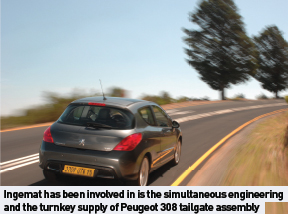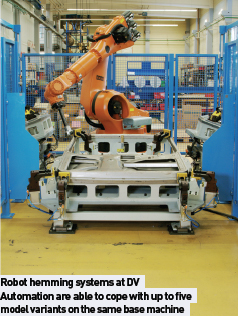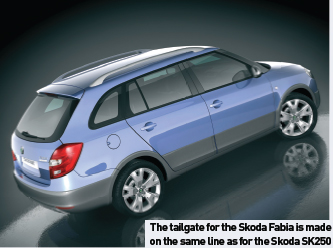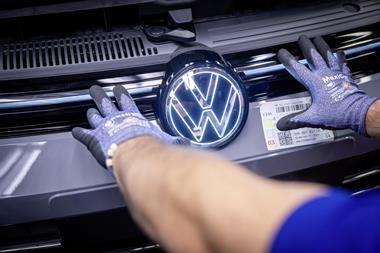Folding metal for a good finish is an increasingly complex task as production lines become more flexible and body parts get more intricate. AMS looks at two suppliers leading the field in table top and robot hemming
Accurate hemming, where the inner and outer panels are joined, is crucial to the quality of a car’s appearance. Defects, such as surface deflection or twist, can be costly and even mean the complete rejection of the vehicle during the final stage of production.
Although a fairly traditional activity, it has been hit by the vagaries of modern manufacturing methodology, including increased automation and the demands of flexible assembly. “One of the main trends that we have noticed recently is that of flexibility, as more manufacturers have chosen flexible manufacturing techniques to produce several variants of one model on the same production line,” says Mark Schlanker, Business Manager at DV Automation.
“Hemming is more a science than a technology,” adds Ernesto Olaortua, Product Manager, at Ingemat. “Together with the design of a fixture or simple folding machine, you have to take into account materials knowledge and knowhow on how steel behaves when different forces are applied to get it to fold.”
There are two main variants of the hemming process: a table top approach and a robotised system. “The demand for greater flexibility has led to the development of flexible table top and robot hemming systems which, via their quick tool change capability, are able to cope with up to five model variants on the same base machine,” says Schlanker. “It is also important that these systems allow for the easy inclusion of new tooling for future models.
“As a company we can offer flexible hemming, either based on a robot hemming system or a flex hemmer electro-mechanical, flexible table top hemming machine. These systems, while extremely flexible, are also highly cost-effective, which is another key criteria we have to meet.
“They can undertake all common hem types and can hem a number of different components in a single cell. We are now supplying more turnkey closure hemming systems that not only include the hemming machine, but all the associated assembly processes, such as welding and sealing.”
Ingemat has developed table top and robotised roller hemming. Table top is a technology integrated in the assembly line and is characterised by a fixed hemming bed, fixed part and units with mobile hemming blades. Each hemming unit covers between 600 and 1,800mm (2,000mm in straight areas) of the part perimeter and each unit is oriented as perpendicular as possible to the outer surface of the part. The vertical movement of the hemming unit allows the forces to be applied directly on to the flange and from this to the hemming bed, without penalising the auto part.
Another characteristic is that the hemming blades for the pre-hemming step incorporate a variable angle depending on the hemming flange and its characteristics.
This allows ‘homogeneous hemming’ regardless of the angle or the height of the flange. The table top technology is universally applied but is more profitable for high production rates, above 50-60 cars/hour.
As for robotised roller hemming, the company has developed a simulation to define critical product and fixture characteristics. Robot roller hemming is highly profitable for production rates of 50 vehicles or less.
The complexity of the panels used in the automotive industry, especially with regard to more complex bonnets and liftgates, is compounded by the increased use of lightweight materials such as aluminium.
Despite this increased flexibility Schlanker confirms that the process is still primarily used for the production of automotive closures such as doors, bonnets and bootlids. As for the types of machines in use, he says that the requirement for dedicated table top machines has decreased but this has been replaced by the use of robots and flexible table top systems.
At Ingemat a hemming project begins with the hemming simulation. This helps to define the steel sheet and fixture parameters from the very beginning of the project. “Starting from the material characteristics and with the foreseen cinematic of the hemming system, we use iterations to assure the optimal product quality result,” Olaortua explains. “This information reduces the hemming fixture try-out period and the number of parts needed for the try out.
“Hemming technology is always developing and growing, and will continue as long as there are cars bodies of metal (steel, steel with high elastic limit, aluminium). The robotised roller-hemming technology adapts to the current production programmes of car manufacturers and allows a greater variety of models and lower production rates, particularly with special models of cars such as coupés or cabrios.
“At Ingemat we have a hemming committee with five hemming experts that periodically analyse the market situation, market trends, and the feedback of our customers to evaluate and to promote improvements. Hemming is therefore alive and in constant evolution to adapt to the market needs.”
Talking about the market leads neatly onto the future trends, which according to Ingemat are strong. “From our point of view, the market cycle is now at a slightly lower level until 2008, and from there on it will maintain or increase in the use of hemming machines,” Olaortua says. “We foresee a higher usage of robotised roller hemming due to the current trend of developing numerous spin-offs from each car model family.”
 What is making life difficult for UK companies is the threat from low-wage economies. “Due to expansion of car manufacturers in low-cost countries – East Europe, India, China and South America – there is more competition, so European suppliers will have to search for an optimal cost and a good quality/price ratio,” he continues.
What is making life difficult for UK companies is the threat from low-wage economies. “Due to expansion of car manufacturers in low-cost countries – East Europe, India, China and South America – there is more competition, so European suppliers will have to search for an optimal cost and a good quality/price ratio,” he continues.
“We have noticed in the last months a slight decline in the investment because some manufacturers like Peugeot Citroën are introducing a lower number of new cars in the market or because the VW Group has reviewed its new car programmes.
There is another factor nowadays: the need to fill workshop capacity, so that they give less volume of orders to suppliers.
One recent project that Ingemat has been involved in is the simultaneous engineering and the turnkey supply of the Peugeot 308 tailgate assembly line. The line has a cycle time of 36 seconds and production rate is 1,900 cars/day.
Regarding hemming, there were two areas where the metal sheet had to be folded: the outer perimeter and the rear glass frame. During the simultaneous engineering stage, Ingemat engineers studied the possibility of complete tailgate hemming in one single hemming fixture. As the sub-assembly characteristics proved that it was impossible to perform the complete hemming in just one fixture, robotised roller hemming was considered to hemm the rear glass window.
Ingemat’s roller hemming solution (one robot and one fixture) proved to be economical and simple from a mechanical and maintenance point of view. Furthermore, tests demonstrated that a conventional ABB 6600 robot could be used for the roller hemming station. For the outer perimeter and table-top hemming fixture with holding clamps was used.
Skoda is another OEM that has recently benefited from Ingemat’s hemming experience. A slower production rate of 1,100 vehicles per day on the Fabia SK250 and Fabia Combi SK252 line had the added complication of two different tailgates on the one production line. The solution was separate table top hemming fixtures for the two cars with common holding clamps, electrically driven, with corner flange preparation from 125 degrees to 90 degrees.
For their part DV Automation has recently installed a variety of systems including dedicated table top machines for the production of prestige body panels for a major automotive OEM. The company has also supplied a single flexible robot hemming cell for a major automotive Tier One supplier that produces three different panels for three different vehicle models, with the ability to add new model panels at a later date.




































